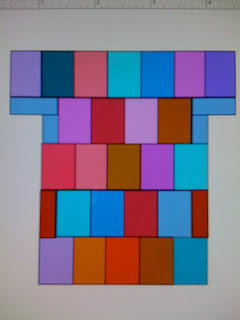While I thought about you and your sister, I cast on the first sleeve. Since this will be a museum piece and the cuffs are K1P1 ribbing, I tried "tubular cast on." What an odd process it is. I was going to try to describe the method here, but there are so many good tutorials on the Internet, my description would be worthless. (I noticed, when I searched, that there are lots of different ways to accomplish the same thing. I used the technique from "The Knitter's Book of Finishing Techniques" by Nancie Wiseman, a very useful little book that's spiral-bound--so it lies flat!)
 More glorious colors! You can clearly see that I'm using 2 or 3 different colors at once. KF's favorite technique with this coat is to gradually change colors (AAB for a few rows, then ABB, then ABC)--and then abruptly change to a very different colorway. For example, the first two rows of ribbing have a purple strand in with two shades of red. In Rows 3 and 4, the purple is exchanged for a brown. Then the purple's back, brown is out and in comes fuchsia. Then what looks like a complete change, but it's the purple and brown again without red.
More glorious colors! You can clearly see that I'm using 2 or 3 different colors at once. KF's favorite technique with this coat is to gradually change colors (AAB for a few rows, then ABB, then ABC)--and then abruptly change to a very different colorway. For example, the first two rows of ribbing have a purple strand in with two shades of red. In Rows 3 and 4, the purple is exchanged for a brown. Then the purple's back, brown is out and in comes fuchsia. Then what looks like a complete change, but it's the purple and brown again without red. Here's a sample of the pattern for the panels I just finished. The repetition isn't obvious at first because the letters are alphabetized. But follow a letter like F or U (both red-burgundies) or X (brown) or N (purple) and see how they appear consecutively, then disappear, then reappear in an even different combination.
 (My pencilled numbers down the left are the number of rows on that line of pattern, and down the right, the number of stitches I should have by the end of that line.)
(My pencilled numbers down the left are the number of rows on that line of pattern, and down the right, the number of stitches I should have by the end of that line.)And now for something completely different (I just can't resist using that old segue from "Monty Python"): I tried my hand at needle felting for the first time yesterday, following the directions in "Little Felted Animals" by Horvath & Boutin. There's a visual joke here: you can see the gray water and gray beach, and gray, gray sky in the background, so the possibility of such a brightly colored bird in this part of the world is nearly zero! I used dyed roving purchased last year at the Maryland Sheep & Wool. My teeny black buttons were too big for the eyes; I'll try french knots of embroidery thread. Cute for a first try, but I'll keep my day job...











































